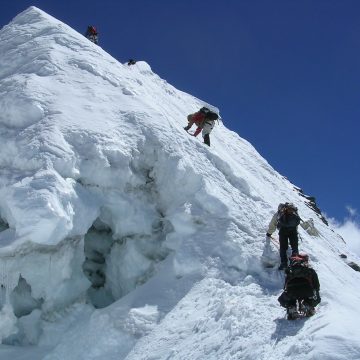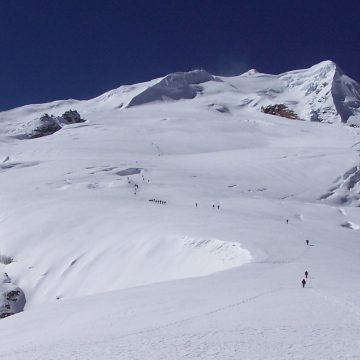The world Highest mountains Mt. Everest (29000 ft) is located 27, 59’ north latitude, 86 0 55’ east longitude. It was accredited as the highest mountains on the earth in 1852. The towering mountain in between the international border of Nepal and Tibet. In Nepali, it is known as “Sagarmatha” which means forehead of the earth and in Tibetan people call it “Chomolongma” which means mother goddess in a local language.
Mt. Everest has its own significance to climb. It results that Mt Everest is climbed by more people rather than other mountains. There has been many attempts for climbing Mt. Everest by British group along with George Mallory in 1921, 1922 & 1925. 1925 was one of the first tragic days in the history of Everest climbing. On June 2, 1924, Mallory and Irvine, had left their high camp for the summit attempt, they were missed in the Everest. Still, their bodies were not found.
After the successful summit of Tenzing Norgay Sherpa and Edmund Hillary in may 1953, there have been many attempts in Mt. Everest, including the people who climbed it two or more times. It is a great achievement for those who climbed it or not. Both of them could face dreadful obstacle – technical, physical, psychological.
Discovery of Everest
Officially world highest mountain was discovered in the decades of 1850s by British-led surveyor Andrew Waugh. Before this, long surveyed were done to discover the world tallest point. The British began the Great Trigonometric survey of India in 1802, but because of Political aggression, they were not allowed to enter Nepal. Still, different surveying project was held my British, but because of Malaria, surveyor were killed. Nonetheless British continue their Great Trigonometric survey and in 1847, observing the mountains parallel form 240 km away in November 1847 Surveyor General of India, Waugh, consider Kanchenjunga as the tallest mountain in the world, but simultaneously he noted the next peak 230 km away from it. Other members of Waugh also noted that peak which seems taller than Kanchenjunga. Finally, they called it Peak ‘B’ and conclude as the higher mountains on the planet. Later Surveyor James Nicolson continues the project and collects the data’s observing from 5 different points and calculates the height of Peak ‘B’. According to the James Nicolson raw date the height of Peak ‘B’ was 9200m (30,200 ft). Unfortunately, Nicolson was forced to return because of Malaria, without completing his survey. However, Nicolson proved the fact that Peak ‘B’ is taller than Kanchenjunga.
Finally, the uncompleted task of Nicolson was complete by Indian mathematician and surveyor Radhanath Sikdar in 1852. He was the first to discover world highest peak, using the calculation based on Nicolson’s measurement. Later on 1856, March, Waugh and his team declared Peak XV as the highest mountain on the planet with the height of 29000 ft (8839.2m). The Romanic numerical name Peak XV was designated by Michael Hennessy, one of the members of Surveyor Team.
Waugh and his team, wants to name the Peak by local named, however, they were unable to find the specific local name of world tallest mountain. Finally they were argued to give the name by the name of respected chief and predecessor, Colonel Sir George Everest, however, George Everest personally opposed it. But finally, in 1865, the Royal Geographical Society officially adopted Mount Everest as the name for the highest mountain in the world.
Though Waugh and his surveyor team discovered the height of Everest 29002 ft (8840m), it was not officially recognized, the first officially recognized height of Everest is 20029 ft (8848m) from sea level, discovered by Indian Survey in 1955, which was also officially recognized by Nepal and China.
First Accents
May 29, 1953 By Sir Edmund Hillary And Tenzing Norgay Sherpa From South East Ridge
Location
27°59'17'' N / 86°55'31'' E
Himalayan Range
Mahalangur Himalaya
Approach Route
South East Ridge (Normal)
MEANS OF TRANSPORT
Motors Vehicle/ Aircraft/Heli Charter
Difficulty
Easy - Medium

Accomodation
5 Star In Kathmandu, Attached Tea House And Tented Camp
Meals Plan
B/B In Kathmandu, MAP During Trekking And Climbing
Best Season
Spring Starts From First Week Of April
Includes
- Airport transfers in Kathmandu (All necessary airport transfer will be arrange).
- 6 nights 5-star hotel in Kathmandu including breakfast.
- Kathmandu– Lukla – Kathmandu flight for a member, staff, and equipment No limit for baggage, we will arrange porters, pays necessary cargo for all baggage.
- Yaks and Porters for transportation of equipment from Lukla to Base Camp and back.
- Food and accommodation on tea houses on the way to base camp and back.
- Acclimatization climb to Island Peak (6189m) before climbing Everest.
- 1 Personal climbing Sherpa to each climber.
- Cook and Kitchen Helper at Base Camp.
- Cook at Advanced Base Camp.
- All kitchen and Dining equipment for Base Camp and ABC.
- Food, fuel, fresh vegetables, fruits, and meat at base camp during the expedition.
- High altitude food and fuel for ABC and other high camps.
- High-quality tents for all camps.
- All group climbing equipment.
- Communication and electrical equipment for the mountain.
- 6 bottles of 3 ltr Poisk oxygen for member; 3 each for the Sherpas; regulator and mask.
- Everest Climbing Permit.
- Icefall usage charges.
- Liaison officer’s equipment allowance, daily salary and other expenses.
- Equipment allowance and daily wages for all Nepali staffs.
- Insurance for all Nepali staffs and porters including helicopter rescue provision.
Excludes
- Meals in Kathmandu.
- All personal climbing equipment.
- All personal expenses.
- Summit bonus and tips for the staffs.
- Personal medical and evacuation insurance for climbing members.
- Garbage Deposit (US$4000 – refundable after bringing back garbage from mountain).
- All other additional charges for additional services.
Cost starts from USD $ 38,000 (USD Thirty Eight Thousand) per person fully guided Expedition, 1:1 professional climbing Sherpa. 8 Oxygen Cylinder per member provided.































